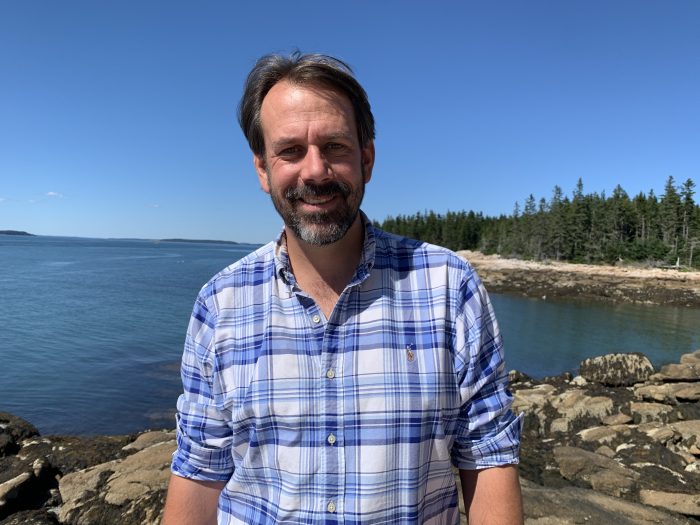SBU’s Sean Clouston finds more wind means less COVID-19 transmission
By Daniel Dunaief
The same wind that powers sailboats, makes kites dart through the air, and causes flags to flutter can make being outdoors in a group safer, particularly during the pandemic.
While public health officials have suggested that being outdoors with others amid the pandemic is safer than remaining inside, the strength of the wind can affect the level of protection provided by wide open spaces.
That’s the conclusion Sean Clouston, Associate Professor in the Program in Public Health and the Department of Family, Population and Preventive Medicine at the Renaissance School of Medicine at Stony Brook University, reached after studying public health data from 96,000 cases of COVID in Suffolk County from March 16, 2020 to December 31, 2020.
By combining public health data with the daily reports from the National Oceanic and Atmospheric Administration, Clouston found that days in which the temperature was between 60 and 84 degrees Fahrenheit and in which the wind was about 5 miles per hour or less had higher COVID-19 transmission than those days in which the wind speed was faster.
This kind of study, which was recently published in the journal BMC Infectious Disease, might affect the guidance policy makers provide to reduce the risk of COVID transmission during outdoor gatherings.
“If you’re imaging yourself as a policy maker and you want to contain COVID, what do you do?” Clouston asked rhetorically. Vaccines and masks are established tools. Ensuring airflow is higher might also be important, he suggested.
Indeed, amid the early days of the pandemic in 2020, public officials closed parks in Suffolk County for a while and eventually reopened them.
An alternative could be to provide access to parks where wind speed is also protective, or to reduce the use of parks where social distancing is difficult and where wind speed is lower.
At the same time, residents might want to protect themselves by putting out fans in their backyard or some other airflow devices to keep the flow of air moving during a social gathering, reducing the chance of transmitting the virus. People might want to avoid using tents that reduce the flow of air around them.
Additionally, people could eat out at restaurants where the airflow is stronger.
Diners can search for places where the air “moves around, so the outdoor experience is as protective as possible,” Clouston said. He recognized that the data had some variability between when people who went outside might have contracted COVID. The air flow could increase and then decrease and the average length of time from exposure to symptoms and testing could differ between people.
“Any time we deal with humans, this is the problem,” Clouston said. Researchers can’t control for everything. Instead, they have to assume people make decisions in a consistent, but variable, way.
The larger data set, with close to 100,000 cases, enabled Clouston and his colleagues to average out the effects of the time when people reported their positive COVID tests.
For numerous cases, people had a good idea where and how they contracted COVID. Even when they were at outdoor events, such as a barbecue, some people had indoor parties where they ate together.
In addition, merely being outdoors didn’t reduce the risk if people were standing in the equivalent of stale air, where wind couldn’t reach them and help carry viral particles away from others who attended these events.
Being outside if the air isn’t moving is similar to being indoors in a space with a very large ceiling and a wide space between walls, he explained. It is safer than a small room, but it is not inherently safe on its own.
As for air circulation indoors, Clouston said people have suggested that moving air in buildings could reduce the spread of the virus.
Testing the effects of having HEPA filters or air filtration systems run continuously in hospitals compared to areas that don’t have such units could reveal the benefit of having these air flow systems. Some studies have been done on this, although more work is ongoing, he said.
Clouston suggested that other environmental conditions could also impact the transmissibility of the virus. The heat index, for example, might explain why wind speed might be important.
The heat index “might diminish the effect or make it stronger,” Clouston said. “It can push people indoors.”
Clouston worked on this study with Stony Brook colleagues in the Department of Family, Population and Preventive Medicine Assistant Professor Olga Morozova and Professor Jaymie Meliker. The team has worked with the Suffolk County Department of Health since 2020 on different aspects of COVID modeling.
Clouston was surprised that the research revealed a threshold model wind speed. He was also surprised to see that the speed was so low. “You only need a little airflow,” he explained.
The Stony Brook scientist looked at where the positive cases were located by zip code. The summer distribution and the spatial distribution was somewhat unclear, he said.
The spread of COVID was distributed by population size and density. Population size and density are likely more important than alterations in microclimate in the summer.
The analysis is important for places when and where outdoor exposures are most common, he explained.
“This may be true in the summer on Long Island or in the winter in southern states like Louisiana when outdoor activities are more comfortable,” he wrote in an email.
Clouston has several ongoing projects. He has papers discussing the role of social inequalities and COVID, a paper looking at clinical risk factors for COVID at Stony Brook Hospital, and one describing the initial wave of COVID in World Trade Center responders.
He would like to look at the effect of outdoor protests during 2020 on the spread of COVID, which would require data on attendance at those events and at the ones in New York City.







